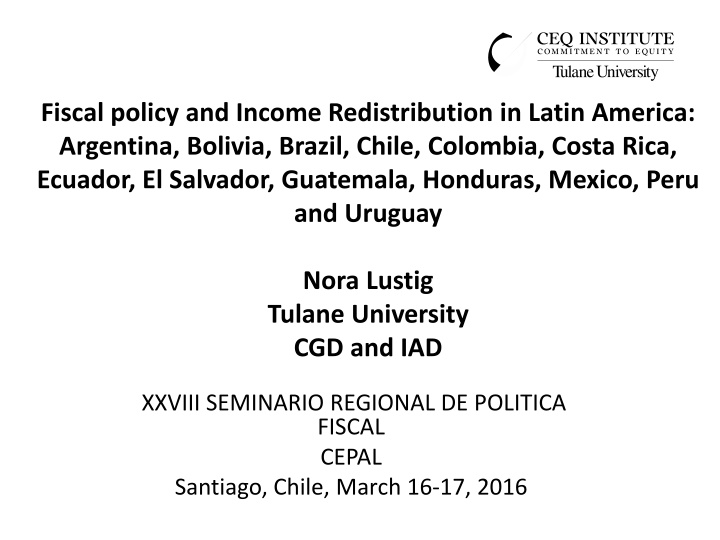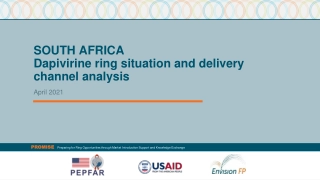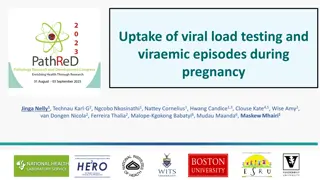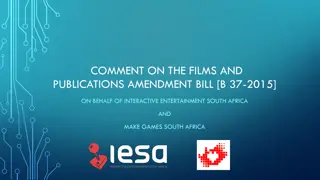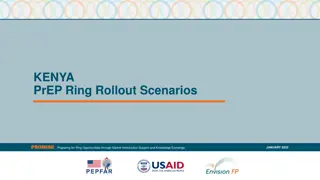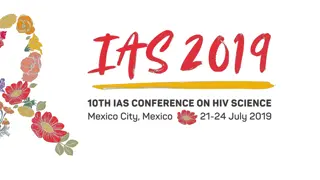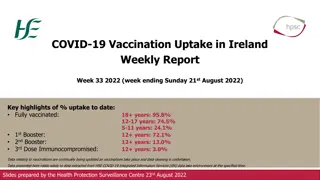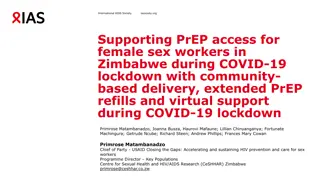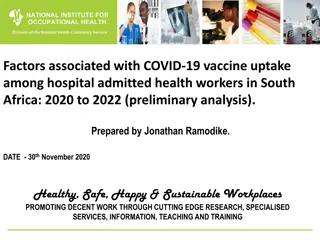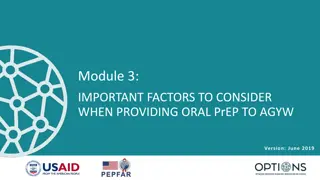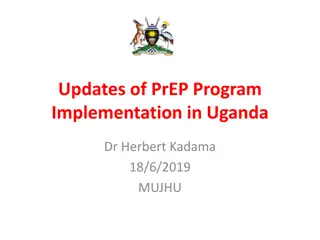Cost-effectiveness of PrEP in South Africa: Target Populations and Uptake Impact
The impact of differential PrEP uptake by HIV risk groups on cost-effectiveness in South Africa. Understand the implications for different target populations and self-selection based on risk levels.
Download Presentation

Please find below an Image/Link to download the presentation.
The content on the website is provided AS IS for your information and personal use only. It may not be sold, licensed, or shared on other websites without obtaining consent from the author.If you encounter any issues during the download, it is possible that the publisher has removed the file from their server.
You are allowed to download the files provided on this website for personal or commercial use, subject to the condition that they are used lawfully. All files are the property of their respective owners.
The content on the website is provided AS IS for your information and personal use only. It may not be sold, licensed, or shared on other websites without obtaining consent from the author.
E N D
Presentation Transcript
Fiscal policy and Income Redistribution in Latin America: Argentina, Bolivia, Brazil, Chile, Colombia, Costa Rica, Ecuador, El Salvador, Guatemala, Honduras, Mexico, Peru and Uruguay Nora Lustig Tulane University CGD and IAD XXVIII SEMINARIO REGIONAL DE POLITICA FISCAL CEPAL Santiago, Chile, March 16-17, 2016
Source: Lustig, Nora. 2016. El impacto del sistema tributario y el gasto social en la distribuci n del ingreso y la pobreza en Am rica Latina: Argentina, Bolivia, Brasil, Chile, Colombia, Costa Rica, Ecuador, El Salvador, Guatemala, Honduras, M xico, Per y Uruguay. CEQ Working Paper No. 47, Commitment to Equity Institute, Tulane University, forthcoming. To be published in El Trimestre Econ mico. Study prepared for the Divisi n de Administraci n Fiscal y Municipal of the Inter-American Development Bank 2
Commitment to Equity Institute (CEQI) Research-based policy tools Data Center Advisory and training services Bridges to policy Grant from Bill & Melinda Gates Foundation US4.9 million for 5 yrs 3
CEQ Institute: Core Staff Director: Nora Lustig Director of Policy Area: Ludovico Feoli Associate Directors: Maynor Cabrera, Jon Jellema, Estuardo Moran and Stephen Younger Technical Coordinator: Sandra Martinez Data Center Director: Sean Higgins Communications Director: Carlos Martin del Campo 4
Commitment to Equity Institute Working on close to 40 countries; covers around two thirds of the world population Over 100 collaborators Collaborative efforts and partnerships with multiple organizations: AfDB, CAF, IDB, IMF, ICEFI, OECD, Oxfam, UNDP, World Bank Utilized by governments Working Paper series and numerous scholarly publications 5
CEQ Assessment: Tools Handbook: Lustig and Higgins, current version Sept 2013, updated Feb 2016; includes sample Stata code CEQ Handbook 2016 (forthcoming) Lustig, Nora, editor. Commitment to Equity Handbook: Estimating the Redistributive Impact of Fiscal Policy , Tulane University and the World Bank Master Workbook: Excel Spreadsheet to present background information, assumptions and results. Diagnostic Questionnaire: = > available on website Ado Stata Files 7
CEQ Assessment: Method Relies on state-of-the art tax and benefit incidence analysis Ongoing consultation with experts to improve economic incidence estimates Uses conventional and newly developed indicators to assess progressivity, pro-poorness and effectiveness of taxes and transfers Allows to identify the contribution of individual fiscal interventions to equity and poverty reduction objectives Lustig & Higgins (2013) 8
CEQ Assessment: Fiscal Incidence Analysis Income after taxes and transfers Taxes Transfers Yh = Ih- iTiSih + jBjSjh Share of transfer j received by unit h Share of tax i paid by unit h Income before taxes and transfers 9
CEQ Assessment: Fiscal Interventions Currently included: Direct taxes Direct cash transfers Non-cash direct transfers such as school uniforms and breakfast Contributions to pensions and social insurance systems Indirect taxes on consumption Indirect subsidies In-kind transfers such as spending on education and health Working on: Corporate taxes Housing subsidies Lustig & Higgins (2013) 10
CEQ Assessment: Income Concepts MARKET INCOME PLUS DIRECT TRANSFERS MINUS DIRECT TAXES DISPOSABLE INCOME PLUS INDIRECT SUBSIDIES MINUS INDIRECT TAXES POST-FISCAL or CONSUMABLE INCOME PLUS MONETIZED VALUE OF PUBLIC SERVICES: EDUCATION & HEALTH FINAL INCOME 11
Fiscal Incidence in CEQ Assessments Accounting approach no behavioral responses no general equilibrium effects and no intertemporal effects but it incorporates assumptions to obtain economic incidence (not statutory) Point-in-time Mainly average incidence; a few cases with marginal incidence Lustig & Higgins (2013) 12
Fiscal Incidence in CEQ Assessments Comprehensive standard fiscal incidence analysis of current systems: direct personal and indirect taxes (no corporate taxes); cash and in-kind transfers (public services); indirect subsidies Harmonized definitions and methodological approaches to facilitate cross-country comparisons Uses income/consumption per capita as the welfare indicator Allocators vary => full transparency in the method used for each category, tax shifting assumptions, tax evasion Secondary sources are used to a minimum Lustig & Higgins (2013) 13
Allocation Methods Direct Identification in microdata However, results must be checked: how realistic are they? If information not directly available in microdata, then: Simulation Imputation Inference Prediction Alternate Survey Secondary Sources Lustig & Higgins (2013) 14
Tax Shifting Assumptions Economic burden of direct personal income taxes is borne by the recipient of income Burden of payroll and social security taxes is assumed to fall entirely on workers Consumption taxes are assumed to be shifted forward to consumers. These assumptions are strong because they imply that labor supply is perfectly inelastic and that consumers have perfectly inelastic demand In practice, they provide a reasonable approximation (with important exceptions such as when examining effect of VAT reforms), and they are commonly used Lustig & Higgins (2013) 15
Tax Evasion Assumptions: Case Specific Income taxes and contributions to SS: Individuals who do not participate in the contributory social security system are assumed not to pay them Consumption taxes Place of purchase: informal markets are assumed not to charge them Some country teams assumed small towns in rural areas do not to pay them Lustig & Higgins (2013) 16
Monetizing in-kind transfers Incidence of public spending on education and health followed so- called benefit or expenditure incidence or the government cost approach. In essence, we use per beneficiary input costs obtained from administrative data as the measure of average benefits. This approach amounts to asking the following question: How much would the income of a household have to be increased if it had to pay for the free or subsidized public service at the full cost to the government? Lustig & Higgins (2013) 17
Treatment of Contributory Social Insurance Pensions Deferred income in actuarially fair systems: pensions included in market income and contributions treated as mandatory savings Government transfer: pensions included among direct transfers and contributions treated as a direct tax Lustig & Higgins (2013) 18
Scenarios and Robustness Checks Benchmark scenario Sensitivity to: Changing the original income by which hh are ranked: e.g., market income plus contributory pensions and disposable income Using consumption vs. income Per capita vs. equivalized income or consumption Different assumptions on scaling-down or up Different assumptions on take-up of transfers and tax shifting and evasion Alternative valuations of in-kind services Other sensitivity scenarios: country-specific Lustig & Higgins (2013) 19
FISCAL POLICY, INEQUALITY AND POVERTY IN LATIN AMERICA: HIGHLIGHTS
Teams and references by country: (in parenthesis: survey year; C=consumption & I=income) 1. Argentina (2012-13; I) Rossignolo, Dar o. 2016. CEQ Masterworkbook, CEQ Institute, Tulane University (February 28, 2016) Bolivia (2009; I): Paz Arauco, Ver nica, George Gray Molina, Wilson Jim nez Pozo, and Ernesto Y ez Aguilar. 2014. Explaining Low Redistributive Impact in Bolivia. In Lustig, Nora, Carola Pessino and John Scott. 2014. Editors. The Redistributive Impact of Taxes and Social Spending in Latin America. Special Issue. Public Finance Review, May, Volume 42, Issue 3. (September 22, 2014) Brazil (2009; I): Higgins, Sean and Claudiney Pereira. 2014. The Effects of Brazil s Taxation and Social Spending on the Distribution of Household Income. In Lustig, Nora, Carola Pessino and John Scott. 2014. Editors. The Redistributive Impact of Taxes and Social Spending in Latin America. Special Issue. Public Finance Review, May, Volume 42, Issue 3. (November 4, 2014) Chile (2013, I): Mart nez-Aguilar, Sandra and Eduardo Ortiz-Juarez. 2015. CEQ Masterworkbook, CEQ Institute, Tulane University and the World Bank (December 9, 2015) Colombia (2010, I): Melendez, Marcela, Nora Lustig and Valentina Mart nez. 2015. CEQ Masterworkbook, Tulane University (December 17, 2015) Costa Rica (2010; I): Sauma, Juan and Diego Trejos. 2014. Social Public Spending, Taxes, Redistribution of Income, and Poverty in Costa. CEQ Working Paper No. 18, Center for Inter-American Policy and Research and Department of Economics, Tulane University and Inter-American Dialogue, January. (February 2014) Ecuador: Llerena Pinto, Freddy Paul, Mar a Christina Llerena Pinto, Roberto Carlos Sa Daza, and Mar a Andrea Llerena Pinto. 2015. Social Spending, Taxes and Income Redistribution in Ecuador. CEQ Working Paper No. 28, Center for Inter-American Policy and Research and Department of Economics, Tulane University and Inter-American Dialogue, February. 2. 3. 4. 5. 6. 7. 21
8. El Salvador (2011; I): Beneke, Margarita, Nora Lustig y Jos Andr s Oliva. 2015. El impacto de los impuestos y el gasto social en la desigualdad y la pobreza en El Salvador. CEQ Working Paper No. 26, Center for Inter- American Policy and Research and Department of Economics, Tulane University and Inter-American Dialogue, February. (March 11, 2014) EuropeanUnion (2011, I) : EUROMOD statistics on Distribution and Decomposition of Disposable Income, accessed at http://www.iser.essex.ac.uk/euromod/statistics/ using EUROMOD version no. G2.0. 10. Guatemala (2011; I): Cabrera, Maynor, Nora Lustig and Hilc as Mor n. 2014. Fiscal Policy, Inequality and the Ethnic Divide in Guatemala. CEQ Working Paper No. 20, Center for Inter-American Policy and Research and Department of Economics, Tulane University and Inter-American Dialogue, October. (April 13, 2014) 11. Honduras (2011; I): Casta eda, Ricardo e Ilya Espino . 2015. CEQ Masterworkbook, CEQ Institute, Tulane University (August 18, 2015) 12. Indonesia (2012; C) : Afkar, Rythia, Jon Jellema and Matthew Wai-Poi. 2014. CEQ Master Workbook, Tulane University and The World Bank (February 18, 2014) 13. Mexico (2010; I): Scott, John. 2014. Redistributive Impact and Efficiency of Mexico s Fiscal System. In Lustig, Nora, Carola Pessino and John Scott. 2014. Editors. The Redistributive Impact of Taxes and Social Spending in Latin America. Special Issue. Public Finance Review, May, Volume 42, Issue 3. (September 2013) 14. Peru (2009; I):Jaramillo, Miguel. 2014. The Incidence of Social Spending and Taxes in Peru. In Lustig, Nora, Carola Pessino and John Scott. 2014. Editors. The Redistributive Impact of Taxes and Social Spending in Latin America. Special Issue. Public Finance Review, May, Volume 42, Issue 3. (May 1, 2013) 15. South Africa (2010; I): Inchauste, Gabriela, Nora Lustig, Mashekwa Maboshe, Catriona Purfield and Ingrid Wollard. 2015. The Distributional Impact of Fiscal Policy in South Africa. Policy Research Working Paper 7194, The World Bank, February. (May 5, 2014) 16. United States (2011, I): Higgins, S., N. Lustig, W. Ruble and T. Smeeding (2015), Comparing the Incidence of Taxes and Social Spending in Brazil and the United States , Review of Income and Wealth, forthcoming. 17. Uruguay (2009; I): Bucheli, Marisa, Nora Lustig, M ximo Rossi, and Florencia Am bile. 2014. Social Spending, Taxes and Income Redistribution in Uruguay. In Lustig, Nora, Carola Pessino and John Scott. 2014. Editors. The Redistributive Impact of Taxes and Social Spending in Latin America. Special Issue. Public Finance Review, May, Volume 42, Issue 3. (August 18, 2014) 9. 22
Household Surveys Used in Country Studies Argentina: National Household Survey on Incomes and Expenditures 2012-13 (ENGHo) (I) Bolivia: Encuesta de Hogares, 2009 (I) Brazil: Pesquisa de Or amentos Familiares, 2009 (I) Chile: Encuesta de Caracterizaci n Social (CASEN), 2009 (I) Colombia: Encuesta de Calidad de Vida, 2010 (I) Costa Rica: Encuesta Nacional de Hogares, 2010 (I) Ecuador: Encuesta Nacional de Ingresos y Gastos de los Hogares Urbano y Rural, 2011-2012 (I) El Salvador: Encuesta De Hogares De Propositos Multiples, 2011 (I) EuropeanUnion: see EUROMOD statistics on Distribution and Decomposition of Disposable Income, http://www.iser.essex.ac.uk/euromod/statistics 10. Guatemala:Encuesta Nacional de Ingresos y Gastos Familiares, 2010 (I) 11. Honduras: Encuesta Permanente de Hogares de Prop sitos M ltiples (EPHPEM), 2011 (I) 12. Indonesia:Survei Sosial-Ekonomi Nasional, 2012 (C) 13. Mexico: Encuesta Nacional de Ingreso y Gasto de los Hogares, 2010 (I) 14. Peru: Encuesta Nacional de Hogares, 2009 (I) 15. South Africa: Income and Expenditure Survey and National Income Dynamics Study, 2010-2011 (I) 16. United States:Current Population Survey, 2011 (I) 17. Uruguay: Encuesta Continua de Hogares, 2009 (I) Note: The letters "I" and "C" indicate that the study used income or consumption data, respectively. 1. 2. 3. 4. 5. 6. 7. 8. 9. 23
SIZE AND COMPOSITION OF GOVERNMENT REVENUES AND SPENDING
Government Revenues Composition of Total Government Revenues as share of GDP (circa 2010) (ranked by total government revenue/GDP; GNI right hand scale) 50% 25,000 45% 40% 20,000 35% 30% 15,000 25% 20% 10,000 15% 10% 5,000 5% 0% 0 Guatemala (2011) Honduras (2011) Colombia (2010) El Salvador (2011) Chile (2013) Mexico (2010) Costa Rica (2010) Peru (2009) Ecuador (2011) Uruguay (2009) Argentina (2012) Bolivia (2009) Brazil (2009) Average 13 Countries Direct Taxes Indirect and Other Taxes Social Security Contributions Other Revenues GNI per capita (2011 PPP) GNI per capita for Argentina in 2005 PPP Source: Lustig (2015b) 25
Public Spending Primary and Social Spending as share of GDP (circa 2010) (ranked by primary spending/GDP, GNI right hand scale) 45.0% 25000 40.0% 20000 35.0% 30.0% 15000 25.0% 20.0% 10000 15.0% 10.0% 5000 5.0% 0.0% 0 Guatemala (2011) Colombia (2010) El Salvador (2011) Honduras (2011) Chile (2013) Ecuador Mexico (2010) Peru (2009) Costa Rica Uruguay (2009) Bolivia (2009) Argentina (2012) Brazil (2009) Average 13 Countries (2011) (2010) Social Spending/GDP GNI per capita (2011 PPP) GNI per capita for Argentina in 2005 PPP Source: Lustig (2015b) 26
Size and Composition of Government Budget Composition of Social Spending (ranked by social spending/GDP; GNI right hand scale) 30.0% 25000 25.0% 20000 20.0% 15000 15.0% 10000 10.0% 5000 5.0% 0.0% 0 Direct Transfer Contributory Pensions Education Health Other Social Spending GNI per capita (2011 PPP) GNI per capita for Argentina in 2005 PPP Source: Lustig (2015b) 27
Public Spending vs GNI Primary and Social Spending /GDP vs GNI per capita 45% BRA 40% 35% BOL 30% URY MEX 25% CRI PER BRA ECU CHL URY CRI HND 20% SLV COL BOL 15% GTM MEX CHL COL ECU 10% HND PER SLV GTM 5% 0% 0 1000 2000 3000 4000 GNI per capita ( 2011 PPP) 5000 6000 7000 8000 9000 10000 Primary Spending/GDP Social Spending/GDP 28 Linear (Primary Spending/GDP) Linear (Social Spending/GDP) Source: Lustig (2016)
CEQ Assessment: Income Concepts MARKET INCOME PLUS DIRECT TRANSFERS MINUS DIRECT TAXES DISPOSABLE INCOME PLUS INDIRECT SUBSIDIES MINUS INDIRECT TAXES POST-FISCAL or CONSUMABLE INCOME PLUS MONETIZED VALUE OF PUBLIC SERVICES: EDUCATION & HEALTH FINAL INCOME 30
Fiscal Redistribution Market, Disposable, Consumible and Final Income Gini (circa 2010) (Contributory Pensions as deferred Income ) 0.6000 0.5500 0.5000 0.4500 0.4000 0.3500 0.3000 0.2500 Market Income Disposable Income Consumable Income Final Income Argentina (2012) Bolivia (2009) Brazil (2009) Chile (2013) Colombia (2010) Costa Rica (2010) Ecuador (2011) El Salvador (2011) Guatemala (2011) Honduras (2011) Mexico (2010) Peru (2009) Uruguay (2009) Ginis for Chile are estimated using Total Income. Official figures of inequality are estimated using Monetary Income Source: Lustig (2016) 31
Fiscal Redistribution Market, Disposable, Consumible and Final Income Gini (circa 2010) (Contributory Pensions as Transfer) 0.6500 0.6000 0.5500 0.5000 0.4500 0.4000 0.3500 0.3000 0.2500 Market Income Disposable Income Consumable Income Final Income Argentina (2012) Bolivia (2009) Brazil (2009) Chile (2013) Colombia (2010) Costa Rica (2010) Ecuador (2011) El Salvador (2011) Guatemala (2011) Honduras (2011) Mexico (2010) Peru (2009) Uruguay (2009) Ginis for Chile are estimated using Total Income. Official figures of inequality are estimated using Monetary Income Source: Lustig (2016) 32
Redistributive Effect Change in Gini points: Market to Disposable Income (circa 2010) 0.00 0.800 0.700 -0.05 Gini Ingreso de Mercado Efecto Redistributivo 0.600 -0.10 0.500 0.400 -0.15 0.300 0.200 -0.20 0.100 0.000 -0.25 Contrbutory Pensions as Deferred Income Contributory Pension as Transfer Gini of Market Income (Pensions as Deferred Income) Gini of Market Income (Pensions as Transfers) The Gini coefficients for the United States are for equivalizedincome. Ginis for Chile are estimated using Total Income. Official figures of inequality are estimated using Monetary Income Source: Lustig (2016) 33
Main messages Extent of redistribution very heterogeneous: From Argentina (similar to the European Union) to Honduras (negligible) Contributory Pensions can be equalizing or unequalizing (Colombia, Honduras, Mexico) Lambert, 2001; Lustig et al., forthcoming 34
Table? 4:? Marginal? Contribution? of? Taxes? and? Transfers? (circa? 2010) (Pensions? as? Market? Income) Brazil Chile* Colombia Indonesia** Mexico? Peru? SA*** Average Marginal? Contributions From? Market? to? Disposable? Income Redistributive? Effect 0.0453 0.0340 0.0075 0.0044 0.0236 0.0099 0.0788 0.0291 Direct? taxes 0.0148 0.0154 0.0018 - 0.0131 0.0055 0.0269 0.0129 Direct? transfers 0.0320 0.0190 0.0057 0.0044 0.0109 0.0045 0.0593 0.0194 From? Market? ? to? Post-fiscal? Income Redistributive? Effect 0.0446 0.0370 0.0073 0.0061 0.0308 0.0151 0.0789 0.0314 Direct? taxes 0.0171 0.0179 0.0019 - 0.0140 0.0060 0.0311 0.0147 Direct? transfers 0.0382 0.0220 0.0057 0.0043 0.0113 0.0048 0.0711 0.0225 Indirect? taxes -0.0014 0.0027 -0.0017 -0.0028 0.0027 0.0052 0.0000 0.0007 Indirect? subsidies 0.0008 0.0004 0.0015 0.0052 0.0047 - - 0.0025 Kakwani Direct? taxes 0.1738 0.3481 0.1373 0.0000 0.2411 0.3853 0.1109 0.1995 Direct? transfers? 0.5310 0.9064 0.9233 0.6248 0.7931 0.9612 1.0165 0.8223 Indirect? taxes -0.0536 -0.0172 -0.1986 -0.0513 0.0129 0.0527 -0.0788 -0.0477 Indirect? subsidies 0.8295 0.7978 0.5034 0.0645 0.2457 0.0000 0.0000 0.3487 35 Lustig (2016)
Main messages Analyzing the tax side without the spending side, or vice versa, is not very useful A tax can be regressive but when combined with transfers make the system more equalizing than without the regressive taxes: e.g, VAT in Chile Transfers can be equalizing but when combined with taxes, post-fisc poverty can be higher Lambert, 2001; Lustig et al., forthcoming 36
FISCAL POLICY AND POVERTY REDUCTION
Fiscal Policy and Poverty Reduction Change in Headcount Ratio from Market to Consumable Income (Poverty line $2.50/day 2005ppp; Contributory Pensions as Deferred Income; in %) Guatemala (2011) Honduras (2011) Colombia (2010) El Salvador (2011) Bolivia (2009) Mexico (2010) Brazil (2009) Costa Rica (2010) Ecuador (2011) Chile (2013) Argentina (2012) Uruguay (2009) Peru (2009) 20.0% 8% 10.0% 5% 3% 1% 0.0% -1% -3% -3% -4% -10.0% -7% -7% -9% -10% -10% -15% -15% -20.0% -22% -30.0% -26% -28% -29% -35% -40.0% -35% -50.0% -51% -52% -60.0% -58% -61% -70.0% -71% -80.0% Disposable Income Consumable Income Source: Lustig (2016) 38
Fiscal Policy and Poverty Reduction Change in Headcount Ratio from Market to Consumable Income ((Poverty line $2.50/day 2005ppp; Contributory Pensions Transfers; in %) Guatemala (2011) Honduras (2011) Bolivia (2009) Colombia (2010) El Salvador (2011) Mexico (2010) Ecuador (2011) Costa Rica (2010) Brazil (2009) Chile (2013) Argentina (2012) Uruguay (2009) Peru (2009) 20.0% 6% 10.0% 1% 1% 0.0% -2% -3% -10.0% -5% -6% -9% -12% -13% -14% -15% -20.0% -19% -20% -20% -30.0% -40.0% -35% -36% -42% -43% -50.0% -45% -60.0% -61% -64% -70.0% -66% -68% -80.0% -79% -82% -90.0% Disposable Income Consumable Income Source: Lustig (2016) 39
Main messages Analyzing the impact on inequality only can be misleading Fiscal systems can be equalizing but poverty increasing: Bolivia, Brazil, Guatemala, Honduras Lustig, forthcoming 40
41 Higgins and Lustig (2015)
Fiscal Impoverishment ($1.25/day PPP 2005, Market to Consumable Income) Market income + pensions poverty headcount FI headcount (among whole population) FI headcount among post fiscal poor FI per impoverished as proportion of income Poverty went up or down? Unambiguously progressive? Inequality went up or down? Bolivia (2009) Brazil (2009) Chile (2013) Ecuador (2011) El Salvador(2011) Guatemala (2010) Mexico (2012) Peru (2011) 10.9% 6.5% 0.8% 3.4% 4.3% 12.0% 4.9% 4.4% 6.6% 0.4% 0.0% 0.1% 1.0% 7.0% 0.8% 0.8% 63.2% 10.3% 5.2% 4.1% 27.0% 62.2% 23.7% 21.8% 15.2% 7.7% 5.3% 4.4% 5.2% 6.4% 14.8% 18.5% DOWN DOWN DOWN DOWN DOWN DOWN DOWN DOWN YES YES YES YES YES YES YES YES DOWN DOWN DOWN DOWN DOWN DOWN DOWN DOWN Higgins and Lustig (2015) 42
Main messages Analyzing the impact on traditional poverty indicators can be misleading Fiscal systems can show a reduction in poverty and yet a substantial share of the poor could have been impoverished by the combined effect of taxes and transfers (in Bolivia and Guatemala the share is over 60 percent) Higgins and Lustig (2015) 43
Progressivity of Education Spending Educ Total Same per capita for all; CC =0 Pre-school Same per capita for all; CC =0 Primary Same per capita for all; CC =0 Secondary Same per capita for all; CC =0 Tertiary Progressive CC positive but lower than market income Gini Pro-poor CC is negative Progressive CC positive but lower than market income Gini Pro-poor CC is negative Progressive CC positive but lower than market income Gini Pro-poor CC is negative Progressive CC positive but lower than market income Gini Pro-poor CC is negative Progressive CC positive but lower than market income Gini Pro-poor CC is negative Same per capita for all; CC =0 Regressive CC positive AND higher than market income Gini nd nd nd + + Argentina (2012) + + + + + Bolivia (2009) Brazil (2009) + + nd + nd + nd + nd Chile (2013) + nd Colombia (2010) + + + + nd Costa Rica (2010) + nd + + + nd Ecuador (2011) + + + + El Salvador (2011) + + + + Guatemala ( 2011) + + + + + Honduras (2011) + + + + + Mexico (2010) + + + + + Peru (2009) + + + + + Uruguay (2009) + + + + Source: Lustig (2016) 44
Progresivity of Health Spending Health Same per capita for all; CC =0 Pro-poor CC is negative Progressive CC positive but lower than market income Gini Argentina (2012) Bolivia (2009) Brazil (2009) Chile (2013) Colombia (2010) Costa Rica (2010) Ecuador (2011) El Salvador (2011) Guatemala ( 2011) Honduras (2011) Mexico (2010) Peru (2009) Uruguay (2009) + + + + nd + + + + + + + 45 Source: Lustig (2016)
Main messages Education spending per person tends to decline with income ( pro-poor ) or be the same across the income distribution Middle-classes opting out? Tertiary education spending is equalizing except for El Salvador and Guatemala Health spending per person tends to decline with income ( pro-poor ) or be the same across the income distribution, except for El Salvador, Guatemala and Peru where although not unequalizing per capita spending increases with income Higgins and Lustig (2015) 46
References Afkar, R., Jellema, J., Wai-Poi, M., forthcoming. The Distributional Impact of Fiscal Policy in Indonesia, in: Inchauste, Gabriela and Nora Lustig (Eds.), The Distributional Impact of Fiscal Policy: Experience from Developing Countries. World Bank, Washington, D.C (forthcoming) Beneke, Margarita, Nora Lustig y Jos Andr s Oliva. 2015. El impacto de los impuestos y el gasto social en la desigualdad y la pobreza en El Salvador. CEQ Working Paper No. 26, Center for Inter-American Policy and Research and Department of Economics, Tulane University and Inter-American Dialogue, February. Bucheli, Marisa, Nora Lustig, M ximo Rossi, and Florencia Am bile. 2014. Social Spending, Taxes and Income Redistribution in Uruguay. In Lustig, Nora, Carola Pessino and John Scott. 2014. Editors. The Redistributive Impact of Taxes and Social Spending in Latin America. Special Issue. Public Finance Review, May, Volume 42, Issue 3. Cabrera, Maynor, Nora Lustig and Hilc as Mor n. 2014. Fiscal Policy, Inequality and the Ethnic Divide in Guatemala. CEQ Working Paper No. 20, Center for Inter-American Policy and Research and Department of Economics, Tulane University and Inter-American Dialogue, October. (April 13, 2014) Duclos, Jean-Yves and Abdelkrim Araar. 2007. Poverty and Equity: Measurement, Policy and Estimation with DAD (Vol. 2). Springer. Chapters 7 and 8. (available online) Higgins, Sean and Nora Lustig. 2015. Can a poverty-reducing and progressive tax and transfer system hurt the poor? ECINEQ Working Paper No. 33, April. 47
References Higgins, Sean and Claudiney Pereira. 2014. The Effects of Brazil s Taxation and Social Spending on the Distribution of Household Income. In Lustig, Nora, Carola Pessino and John Scott. 2014. Editors. The Redistributive Impact of Taxes and Social Spending in Latin America. Special Issue. Public Finance Review, May, Volume 42, Issue 3. Higgins, Sean, Nora Lustig, Whitney Ruble and Timothy Smeeding (forthcoming) Comparing the Incidence of Taxes and Social Spending in Brazil and the United States, Review of Income and Wealth. Inchauste, Gabriela, Nora Lustig, Mashekwa Maboshe, Catriona Purfield and Ingrid Wollard. forthcoming. The Distributional Impact of Fiscal Policy in South Africa, in: Inchauste, G., Lustig, N. (Eds.), The Distributional Impact of Fiscal Policy: Experience from Developing Countries. World Bank, Washington, D.C (forthcoming) Jaramillo, Miguel. 2014. The Incidence of Social Spending and Taxes in Peru. In Lustig, Nora, Carola Pessino and John Scott. 2014. Editors. The Redistributive Impact of Taxes and Social Spending in Latin America. Special Issue. Public Finance Review, May, Volume 42, Issue 3. Lambert, Peter J. (2001). The Distribution and Redistribution of Income: A Mathematical Analysis. Manchester University Press. Third Edition. Chapter 11. (not available online) Llerena Pinto, Freddy Paul, Mar a Christina Llerena Pinto, Roberto Carlos Sa Daza, and Mar a Andrea Llerena Pinto. 2015. Social Spending, Taxes and Income Redistribution in Ecuador. CEQ Working Paper No. 28, Center for Inter-American Policy and Research and Department of Economics, Tulane University and Inter-American Dialogue, February. 48
References Lustig, Nora, Ali Enami and Rodrigo Aranda. The Analytics of Fiscal Redistribution. Chapter in Lustig, Nora, editor, Commitment to Equity Handbook: Estimating the Redistributive Impact of Fiscal Policy. , Tulane University and the World Bank (Forthcoming) Lustig, Nora and Marcela Melendez. 2015. The Impact of Taxes and Transfers on Inequality and Poverty in Colombia. CEQ Working Paper No 24, Center for Inter-American Policy and Research and Department of Economics, Tulane University and Inter-American Dialogue. Forthcoming. Lustig, Nora. 2015a. The Redistributive Impact of Government Spending on Education and Health: Evidence from 13 Developing Countries in the Commitment to Equity Project Chapter 17 in Gupta, Sanjeev, Michael Keen, Benedict Clements and Ruud de Mooij, editors, Inequality and Fiscal Policy, Washington: International Monetary Fund. Lustig, Nora. 2015b. Lustig, Nora. 2015b. Inequality and Fiscal Redistribution in Middle Income Countries: Brazil, Chile, Colombia, Indonesia, Mexico, Peru and South Africa. Evidence from the Commitment to Equity Project (CEQ). CEQ Working Paper No. 31, Center for Inter- American Policy and Research and Department ofEconomics, Tulane University and Inter- American Dialogue. Accepted in Journal of Globalization and Development. Lustig, Nora. 2016. El impacto del sistema tributario y el gasto social en la distribuci n del ingreso y la pobreza en Am rica Latina: Argentina, Bolivia, Brasil, Chile, Colombia, Costa Rica, Ecuador, El Salvador, Guatemala, Honduras, M xico, Per y Uruguay. CEQ Working Paper No. 47, Commitment to Equity Institute, Tulane University, forthcoming. To be published in El Trimestre Econ mico. 49
References Lustig, Nora, editor. Commitment to Equity Handbook: Estimating the Redistributive Impact of Fiscal Policy. (Forthcoming) Martinez, Sandra, Alan Fuchs and Eduardo Ortiz-Juarez. 2016 The Impact of Fiscal Policy on Inequality and Poverty in Chile. CEQ Working Paper No. 46, Commitment to Equity Institute, Tulane University and the World Bank, forthcoming. Paz Arauco, Ver nica, George Gray Molina, Wilson Jim nez Pozo, and Ernesto Y ez Aguilar. 2014. Explaining Low Redistributive Impact in Bolivia. In Lustig, Nora, Carola Pessino and John Scott. 2014. Editors. The Redistributive Impact of Taxes and Social Spending in Latin America. Special Issue. Public Finance Review, May, Volume 42, Issue 3. (September 22, 2014) Sauma, Juan and Diego Trejos. 2014. Social Public Spending, Taxes, Redistribution of Income, and Poverty in Costa. CEQ Working Paper No. 18, Center for Inter-American Policy and Research and Department of Economics, Tulane University and Inter-American Dialogue, January. Scott, John. 2014. Redistributive Impact and Efficiency of Mexico s Fiscal System. In Lustig, Nora, Carola Pessino and John Scott. 2014. Editors. The Redistributive Impact of Taxes and Social Spending in Latin America. Special Issue. Public Finance Review, May, Volume 42, Issue 3. 50
